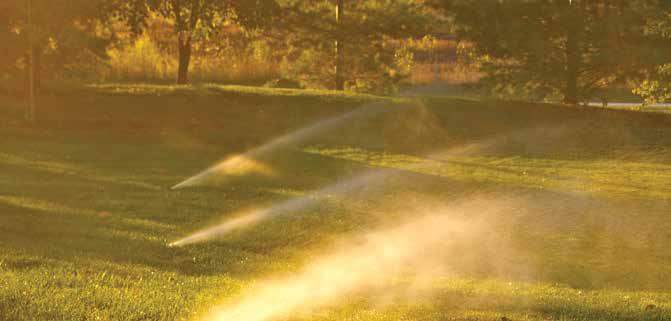
4 minute read
Winterize Sprinkler System
Best Practices for Winterizing Your Sprinkler System
With Kansas City’s fluctuating temperatures, it may be hard to imagine that it’s almost time to winterize your sprinkler system. It’s best to make arrangements now before you wake up on a cold morning to an ice sculpture in your yard—no matter how pretty it may be.
We know why we winterize sprinkler systems here in the Midwest. When water freezes, it expands to approximately 9% of its volume and when in a contained space like a plastic pipe, it expands enough to crack and even shatter the PVC pipe. When PVC pipe freezes, it generally freezes in long lengths instead of small sections, making repairs very difficult and costly!
Winterizing your sprinklers
The best way to prevent this from happening is to have your lawn irrigation system winterized before the coming winter. Ideally, you would want to have this done by Christmas—earlier if you have exposed piping. The winterizing season usually starts the second week of October and runs through to the second to the third week of December, with November being the busiest month.
In the Kansas City metropolitan area, we start winterizing lawn sprinkler systems with what we refer to as “above ground systems.” Sprinkler systems in this category can have a primary water supply pipe exiting the house feeding the system and/or an above-ground backflow prevention device. These are the most vulnerable to freeze damage sooner since the parts, generally made of copper and brass, are exposed to the air and have no heat source such as the ground to keep them from freezing during the first few cold snaps of the fall season.
We have discovered over the years that the freezing point of 32° is not really of immediate concern at the beginning of the season, but if the overnight temperatures reach approximately 27 to 28° any supply pipe and backflow devices with water inside under pressure are likely to be damaged from freezing forces.
So if you have a system with above-ground piping and/or backflow valve above ground, it is best to protect these components from early “hard” freezes by shutting off the water to the sprinkler system, running a cycle with the controller, and covering the exposed components with a thick blanket or towels until your contractor can complete the winterizing service.
Blowing out your irrigation system
After many years of servicing lawn sprinkler systems, we are often asked, “Do I need to blow out my irrigation system?”
The answer is yes, but there is an exception.
Some sprinkler systems are installed with intent in the design, so the system can be winterized by merely shutting off the water at the source and opening a few manual
drain valves in the yard using a forked key. Along with the manual drains, “auto drain” valves are connected to the lateral piping to facilitate water draining. This is great for those that know they have this type of set up. Most of the time nobody knows for sure so, if you’re not the original homeowner and don’t have a map of where the valve boxes are located, we have a small problem. But there is a solution.
This problem can be solved by blowing out the water with compressed air. A large air compressor is attached to the sprinkler system and the zones are activated, which forces the water out through the sprinkler heads, thus emptying the pipes and preventing freeze damage. This method of winterizing sprinkler systems started in the golf course industry and carried over into the residential market, eliminating the guesswork, uncertainty and frustration that came with searching for valve boxes and worrying if the system was drained thoroughly enough to prevent freeze damage.
To eliminate this guesswork, we often design new installations from the start to be blown out every season. This saves not only water from draining away from the use of “auto” drains but saves on costs on the installation with less material and time to install drains in the appropriate places on the system.
Another factor to consider on modern irrigation systems is the use of water-conserving features such as check valves on the sprinkler heads. These check valves prevent water that remains in the pipes after a watering cycle from draining away, just to have to be replenished on the next cycle. These check valves not only “lock in the water” within the pipes but also the head cases as well, making the heads even more vulnerable to freeze damage.
If your system has water-conserving features, it more than likely contains sprinkler heads with check valves and it is best to have your system blown out every season.
So if you are uncertain about your system design, are new to the house, or have had some freeze damage to your system in the past, it is highly recommended to have an irrigation service contractor winterize your sprinkler system every fall by removing the water with air.
ANDY MARSH Irrigation Manager
Andy Marsh is an irrigation service manager at Ryan Lawn and Tree. He has been servicing irrigation systems for 28 years and can be reached at andymarsh@ryanlawn.com or 913-381-1505.










